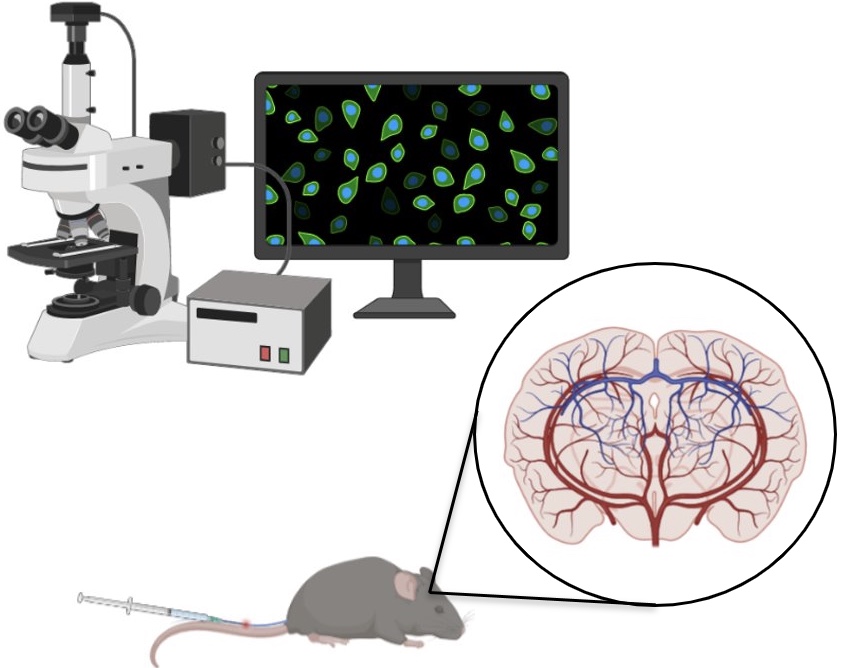The current research projects investigate novel and controllable mechanisms to improve the function of blood vessels in the brain, thus promoting a healthier brain function to sustain the lifespan and quality of the life in older humans susceptible to developing dementia such as Alzheimer's disease.
Inwardly Rectifying K+ (KIR) Channels
Lipid Regulation of Cerebrovascular Inwardly Rectifying K+ (KIR) Channels During Onset of Neurodegenerative Diseases
Vascular inwardly rectifying K+ (KIR) channels, such as KIR2.x and KIR6.x, are important for regulating vasoconstriction and vasodilation to tune cerebral perfusion in response to metabolic demand. We’ve previously identified that disruption in membrane cholesterol during advanced AD pathology restores the function of KIR2.1 channels to that of young, healthy conditions or better. Additionally, we’ve identified specific microRNAs (miRNAs) in cerebral vessels that can be used to track the early development of AD. In addition to serving as diagnostic biomarkers, miRNAs are post-transcriptional regulators that directly or indirectly modulate the activity of KIR2.1 and KIR6.x channels. Because these ion channels are abundant in cerebrovascular endothelium and smooth muscle cells while particularly sensitive to dyslipidemia, we’re seeking to understand specific pathways underpinning the regulation of KIR2.1 and KIR6.x channels in the transition from a healthy to diseased brain to identify points of intervention and translatable treatments.
Senescence
Cerebrovascular Structure and Function in the Aging Brain: Role of Endothelial Cell Ion Channels, Cholesterol, and Senescence
Neurovascular unit (NVU) disorders, which typically manifest as "channelopathies," impact neurotransmission, vascular contractility, and blood-brain barrier permeability and play an integral role in stroke and the development of dementias such as Alzheimer's disease. Cerebrovascular endothelial cells, one component of the NVU, are especially vulnerable during aging, and their ion channels have recently been recognized as innovative therapeutic targets. One such vulnerability identified by our group involves cholesterol-mediated suppression of endothelial inward-rectifying K+ (KIR2.1) channels.
We aim to mechanistically dissect how endothelial cell senescence alters vascular branching, permeability, and the endothelial-dependent regulation of cerebral blood flow. In addition to these experimental methods, we are also developing a computational NVU model for comprehensive examination and modification of activity values across numerous families and individual isoforms of ion channels expressed throughout cell types. Finally, our medicinal pipeline will address KIR2.1 channel impairment, hyperlipidemia, and endothelial cell senescence in the brain through diet, novel lipid-altering agents (e.g., cannabidiol), and senolytics (e.g., quercetin) respectively.

Cannabidiol
The Effects of Cannabidiol on Alzheimer’s Pathology in the 3xTg-AD Mouse Model
Cannabidiol (CBD) is thought to have neuroprotective effects due to its interactions with CB2 receptors in the brain. However, the effects of cannabidiol on Alzheimer’s Disease (AD) progression have not been well studied due to the involvement of CBD in various neural circuits and pathways. Clinical evidence suggests that CBD possesses a desirable safety profile, including anti-inflammatory effects.
In this study, we aim to analyze the effects of cannabidiol on molecular markers that characterize the mild cognitive impairment and Aβ phases of Alzheimer’s Disease in the 3xTg-AD mouse model through a battery of behavioral and molecular tests. Blood and brain samples from the mice will be collected and analyzed after an 8-week period of CBD administration. Our goal with this project is to understand the impact of CBD on molecular, cellular, behavioral, and vascular functions in the aging brain in hopes of finding preventative and therapeutic measures to combat AD progression.
Mitochondrial Calcium Uniporter
Role of the Mitochondrial Calcium Uniporter and Antioxidant Enzymes throughout the Brain During Alzheimer’s Disease
Development of AD has been associated with impaired blood flow to and throughout the brain. In turn, there is diminished delivery of oxygen and nutrients in tandem with reduced clearance of neurotoxic cellular byproducts, notably reactive oxygen species (ROS; e.g., superoxide, peroxide/hydroxyl radicals). As a primary source of cerebrovascular ROS, endothelial mitochondria become progressively dysfunctional in producing ATP relative to ROS in response to aging and cell senescence. A primary mechanism is described by enhanced Ca2+ sequestration into the mitochondrial matrix through the mitochondrial Ca2+ uniporter (MCU) complex (Mcu, Mcub, Mcur1, Micu1, Micu2, Micu3) and a resulting overproduction of ROS up to conditions of cell death. The primary antioxidants that eliminate ROS are superoxide dismutase (Sod2), catalase (Cat), and glutathione peroxidase (Gpx1). Our goal is to gain better understanding of the expression profile differences of the MCU complex and key antioxidant enzymes across brain tissue and cell compartments preceding and accompanying AD pathology.
Selected Publications
- Chum PP, Bishara MA, Solis SR, Behringer EJ. Cerebrovascular miRNAs track early development of Alzheimer’s disease & target molecular markers of angiogenesis and blood flow regulation. J Alzheimer’s Dis. 2023. PMID: 37458037; doi: 10.3233/JAD-230300
- Dietrich A, Behringer EJ, Taylor MS, Sonkusare SK. Editorial: Transient receptor potential channels (TRP): signal transduction. Front Mol Biosci. 10: 1201614, 2023. PMID: 37187892; PMCID: PMC10176508
- Hakim MA & Behringer EJ (2022). KIR channel regulation of electrical conduction along cerebrovascular endothelium: Enhanced modulation during Alzheimer’s disease. Microcirculation. e12797. PMID: 36577656
